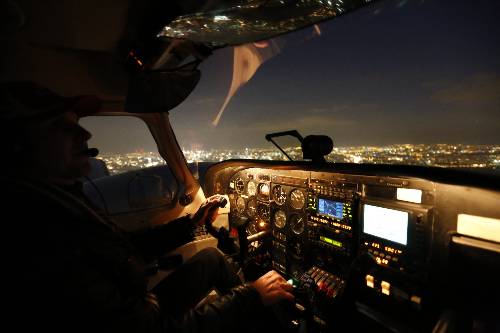CPL(A) commercial licence
Precondtions
- At least 18 years of age
- At least secondary education
- Completed training in line with the programmes of GOLDWINGS FLIGHT ACADEMY
- Total flight time of at least 200 h (including at least 100 h as pilot-in-command)
- 20 h of flight time as pilot-in-command on cross country flights
- Cross country flights of at least 540 km (300 NM) during which 2 full stop landing were made at 2 different airports which were not departure airports
- At least 5 h of night flights (including at least 3 hours of dual flights, including 1 hour of a cross country flight)
- At least 5 solo take-offs and landings
-
What requirements do you have to meet to start a CPL(A) practical course?
- Certificate of completing an ATPL(A) or CPL(A) theoretical course
- Valid Class I medical certificate;
- At least 150 h of total flight time;
- 70 h of flight time as pilot-in-command
Training structure
The training process for the Commercial Pilot Licence consists of the theoretical part followed by the practical one.
The practical course is run based on the programme which is aimed at extending the pilot’s skills to the commercial level. Training tasks focus on controlling a Complex plane and developing skills of instrument flying. Part of training is also dedicated to cross country flights to learn to work modern avionics.
The training programme comprises minimum 23 hours of training flights and 5 hours of simulator flights. To start the training you must have a valid Class I medical certificate.
During the CPL(A) training we also run the multi-engine programme. Combining the two training programmes generates considerable savings as the multi-engine plane is also a Complex plane and it can be used to complete tasks intended for both multi-engine flights and handling functionalities of a Complex plane. A Complex plane is a single or multi-engine plane which features retractable gear and variable pitch propeller controllable from the flight deck.
CPL(A) training in numbers
- training duration: 14 days
- number of training hours: 28
- number of hours on a multi-engine plane: 8; number of FNTP II hours: 5
CPL(A) training: standard option
- Multi-engine piloting course (7 hours of flight time)
The multi-engine rating is one of the basic ratings of a commercial pilot nowadays. Controlling a multi-engine plane involves learning new skills at each stage of the training. At this point of the training the student pilot is taught to take off and land with particular emphasis placed on emergencies which can occur at all stages of flight. A series of exercises dedicated to demonstrate the performance of the plane bot at low and high altitudes is intended to show the capabilities of controlling two engines. MEP(L) training is delivered in circuit flights and sector flights. - Improving navigational skills in cross country flights (10 hours of flight time)
Navigational skills are further improved through navigational flights at lower altitudes. During flights particular emphasis is placed on the precision of navigation. Additionally, some flights are performed with the use of radio navigation instruments as well as GPS systems. It is important to invest that at this stage of training in a plane equipped with higher quality avionics and learn to use all the functionalities available. - Extending instrument rating skills (11 hours of flight time)
Since commercial flying leaves the pilot narrower margin of tolerance in terms of weather conditions under which he or she can perform a flight, therefore improving instrument pilotage skills becomes an important element of the training. During the exercises the instructor places particular emphasis on work organization in the cockpit, improving observation and interpretation of instrument readings as well as precision of pilotage. - Commercial Pilot Licence exam (2 hours of flight)
Taking the practical exam is possible after completing the training programme and meeting minimums at a departure airport.
Raise the level of training for only PLN 1500 and use Cessna 172 equipped with IFR avionics. During the CPL(A) training CESSNA 172 with broad avionics will allow for higher quality training and learning many practical aspects of instrument flights. Longer range of the plane will allow for making longer flights around Poland. GOLDENWINGS has a contract with PETROLOT company for refuelling planes across Poland therefore cross country flights can include all controlled airports domestically and internationally.
Qualifications
We train from scratch by providing professional preparation for work in airlines. If you are looking for a school which will comprehensively train you for an airline job, you have come to the right place! Thanks to professional instructors including active airline pilots and carefully selected planes on which you will be able to do the training in one centre, your progress will be more noticeable.
We also possess an FNTP II simulator on which you will be able to practise all emergencies. During the training we use English standard phraseology.
Advantages
- Convenient airports to train
The training is conducted at airports such as Warszawa Babice, Modlin. These two aerodromes.while Grądy is a small, demanding airfield especially for the MEP(L) training but with low traffic.
Ceny
Prices depend on the training option. IR(A)-rated pilots have a 10-hour shorter instrument training programme. If a pilot is both IR(A) and MEP(L)-rated the training is shortened to 15 hours of flight time. 5 hours on a Complex plane and 10 hours of cross country flights. If you do not have instrument rating experience the programme includes 10 hours of instrument flights, including 5 hours on an FNTP II simulator, 10 hours of cross country flights and 8 hours of MEP(L) training.
We offer CESSNA 172 and PS-28. During the 15 hours of the CPL(A) training programme we provide a higher standard of training.

